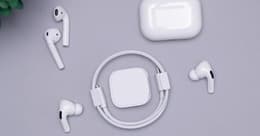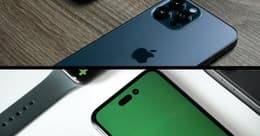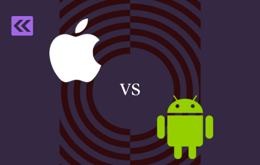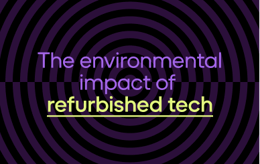
Refurbished tech gets a professional makeover and functions like new, while used tech is sold "as-is" with no guarantees. Refurbished provides peace of mind and quality, while used offers potentially lower upfront costs but a higher risk of problems.
Refurbished. Used. Pre-owned. Secondhand. Aside from the syllable count, there are a lot of (important) differences between a used device and a refurbished one. If you’re seeking tech that's kinder to your wallet and the planet, it can be hard to understand what each word means.
Let’s clear up the confusion. Here’s why we believe refurbished devices are the way to go.
What does refurbished mean when buying tech?
Ever come across the terms "refurbished" and "used" when shopping for tech, and wondered, “what does refurbished mean?” These two options seem similar, but there's a key distinction that impacts your buying experience. Refurbished tech offers a more reliable and secure option compared to simply buying used. Here’s why:
Used technology: Buying “used” or “secondhand” devices means you’re buying the device in “as-is” condition. This means that while the person or place you're buying from may tell you that it works, you really don’t know how well until you have the device in hand. By then, it’s too late to take it back. Used tech like this is typically sold without any sort of return policy or warranty.
Refurbished technology: These devices go through a quality inspection process, ensuring they function to 100% working condition. You can expect excellent performance, with any prior issues addressed and repaired. Unlike used devices, which can be a gamble, choosing refurbished tech offers a much clearer picture.
Feature | Verified Refurbished | Used |
|---|---|---|
Professional restoration | Yes | No |
Quality checks | Yes | No |
Guaranteed functionality | Yes | No |
Cost | $$ (Lower than new, higher than used) | $ (Lowest) |
Warranties | Often included | No (sold “as-is”) |
By opting for refurbished technology, you're essentially getting a pre-owned device with an excellent look, feel and performance, often at a significantly lower price point compared to brand-new models. It also means a more eco-friendly choice—you're giving a pre-loved device a second life, and reducing electronic waste.
So, when comparing "refurbished vs used," refurbished offers a clear advantage in terms of quality, performance, and peace of mind.
What does Verified Refurbished mean?
Refurbished offers a clear advantage in terms of quality, performance, and peace of mind. However, the quality of refurbished items can vary depending on the seller's refurbishment process.
We go beyond just fixing things up. Whether they’re refurbishing phones, laptops, or smartwatches, each seller must run our up to 100-point quality inspection to ensure every device complies with our quality charter. We call this “Verified Refurbished,” and it means everything you see on Back Market has high functionality, tip-top appearance, and maximum security —so you can be confident your phone has a clean slate, with no hidden red flags (or undeleted selfies).
Plus, these devices boast industry-standard battery health, typically exceeding 85% with full charging capacity. And the best part? Choosing refurbished reduces your carbon footprint by a whopping 92% compared to buying new. We know they’re great, but we want to be certain you find them great too. Things like a 1-year warranty, 30 days to change your mind, and free returns for defects. And if something does go wrong, you can talk to real humans, 6 days a week.
What to expect when buying used devices
Here's what to expect when choosing used tech:
Uncertain condition: Battery damage? Scratches? It’s all there. And while the person or place you're buying it from may tell you that it works, you really don’t know how well until you have the device in hand.
No guarantees: Used tech doesn’t typically come with a return policy or warranty. What you see is what you get.
Safety concerns: You don’t know if the device’s electrical wiring is up to snuff—aka, that used MacBook Pro might start a fire. That might sound a little dramatic, but the lack of safety enforcement for used tech is a big problem.
Unreliable performance: There's no way to know how well a used device actually works until you buy it. You might end up with a frustrating tech experience.
Lower price tag: We get it; budgets are important. The biggest draw of used devices is their significantly lower price point compared to both new and refurbished options.
Sure, you might save the most cash when you buy used, but without a guarantee of battery life—or basic functionality—it can be a big risk, especially for a piece of tech that’s so integral to our everyday lives.
What to expect when buying refurbished devices
Refurbished devices offer a fantastic alternative to brand new, with several key benefits:
Excellent performance: Refurbished devices undergo a professional refurbishment process that addresses and repairs any prior issues.
Warranty protection: With refurbished tech comes peace of mind. Many retailers even provide warranty coverage for refurbished devices, offering peace of mind should anything unexpected come up.
Choice in cosmetic condition: The best part? You often have a choice in cosmetic condition, allowing you to select a device that fits your budget—perfect, with minor scratches, and so on.
Thorough inspection: Technicians meticulously examine the device to identify any issues. Devices are also thoroughly cleaned and sanitized, with all previous user data securely erased.
Higher price tag: While much less expensive than brand new, refurbished devices will typically have a higher price point than used devices. This is due to the professional work performed to ensure functionality and quality.
Refurbished tech is the smarter choice if you want to save money without sacrificing reliability.
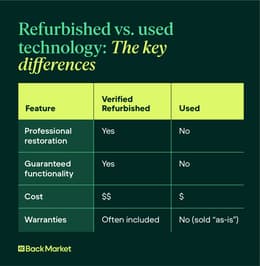
Back Market’s special sauce: How we ensure quality
We’ve developed stress testing for device packaging, and make recommendations so our sellers know how to best package devices, so your device will arrive shipshape and scroll-ready.
Devices undergo procedures like flash and tactile tests to make sure touch screens and cameras are fully functional. We continually monitor our sellers through secret shopping, onsite visits to refurbishment centers, and of course, our customer’s reviews.
How Back Market categorizes refurbished devices
We categorize devices on Back Market by their cosmetic grade, so you know exactly what to expect when your device arrives. Depending on the grade you purchase, you can expect either minimal cosmetic wear and tear or none at all. No matter the cosmetic grade, every device functions in perfect working condition.
Grade: Fair
Screen: May have micro-scratches, which could be slightly noticeable when the screen is on.
Body: Has visible scratches and/or dents.
Grade: Good
Screen: Perfect condition
Body: May have micro-scratches visible from 20 inches away.
Grade: Excellent
Screen: Perfect condition
Body: May have barely visible micro-scratches, not noticeable from 8 inches away.
Grade: Premium
Screen: Flawless condition
Body: No scratches. Premium devices may be gently used or open-box returns.
What does a Fair, Good, or Excellent refurbished phone look like?
Bottom line: Is refurbished or used better?
Is refurbished better than used? It’s a pretty resounding yes. But refurbished is also better than new. When you purchase a smartphone from Back Market, you’re not just getting a like-new device for significantly less. Your environmental impact also shrinks.
On average, a refurbished smartphone has 91.6% less carbon emissions compared to a new smartphone. It also uses significantly less water, raw materials, and e-waste (learn more about sustainability at Back Market).
Refurbished tech is not just guaranteed to work like new, it’s better for the planet, too.





